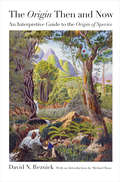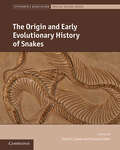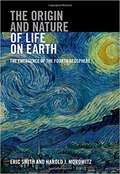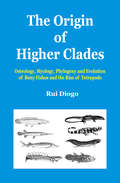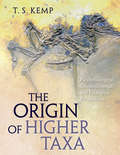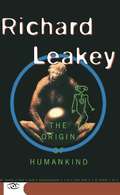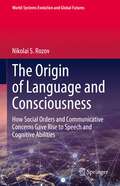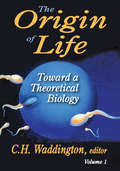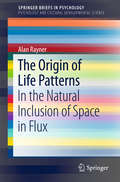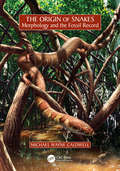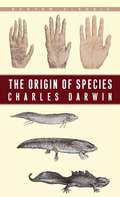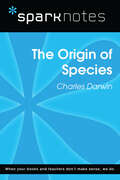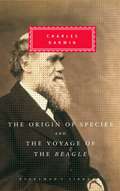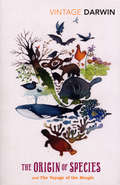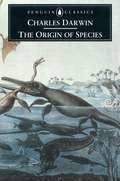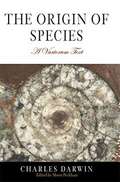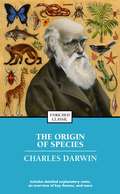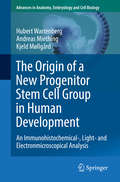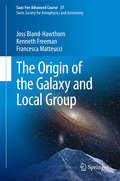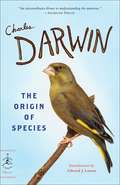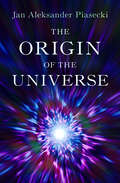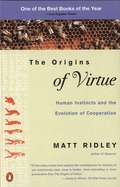- Table View
- List View
The Origin Then and Now: An Interpretive Guide to the Origin of Species
by David N. ReznickAn accessible modern guide to Darwin's masterworkCharles Darwin's Origin of Species is one of the most widely cited books in modern science. Yet tackling this classic can be daunting for students and general readers alike because of Darwin's Victorian prose and the complexity and scope of his ideas. The "Origin" Then and Now is a unique guide to Darwin's masterwork, making it accessible to a much wider audience by deconstructing and reorganizing the Origin in a way that allows for a clear explanation of its key concepts. The Origin is examined within the historical context in which it was written, and modern examples are used to reveal how this work remains a relevant and living document for today.In this eye-opening and accessible guide, David Reznick shows how many peculiarities of the Origin can be explained by the state of science in 1859, helping readers to grasp the true scope of Darwin's departure from the mainstream thinking of his day. He reconciles Darwin's concept of species with our current concept, which has advanced in important ways since Darwin first wrote the Origin, and he demonstrates why Darwin's theory unifies the biological sciences under a single conceptual framework much as Newton did for physics. Drawing liberally from the facsimile of the first edition of the Origin, Reznick enables readers to follow along as Darwin develops his ideas.The "Origin" Then and Now is an indispensable primer for anyone seeking to understand Darwin's Origin of Species and the ways it has shaped the modern study of evolution.
The Origin and Early Evolutionary History of Snakes (Systematics Association Special Volume Series)
by David J. Gower Hussam ZaherSnakes comprise nearly 4,000 extant species found on all major continents except Antarctica. Morphologically and ecologically diverse, they include burrowing, arboreal, and marine forms, feeding on prey ranging from insects to large mammals. Snakes are strikingly different from their closest lizard relatives, and their origins and early diversification have long challenged and enthused evolutionary biologists. The origin and early evolution of snakes is a broad, interdisciplinary topic for which experts in palaeontology, ecology, physiology, embryology, phylogenetics, and molecular biology have made important contributions. The last 25 years has seen a surge of interest, resulting partly from new fossil material, but also from new techniques in molecular and systematic biology. This volume summarises and discusses the state of our knowledge, approaches, data, and ongoing debates. It provides reviews, syntheses, new data and perspectives on a wide range of topics relevant to students and researchers in evolutionary biology, neontology, and palaeontology.
The Origin and Nature of Life on Earth
by Harold J. Morowitz Eric SmithUniting the conceptual foundations of the physical sciences and biology, this groundbreaking multidisciplinary book explores the origin of life as a planetary process. Combining geology, geochemistry, biochemistry, microbiology, evolution and statistical physics to create an inclusive picture of the living state, the authors develop the argument that the emergence of life was a necessary cascade of non-equilibrium phase transitions that opened new channels for chemical energy flow on Earth. This full colour and logically structured book introduces the main areas of significance and provides a well-ordered and accessible introduction to multiple literatures outside the confines of disciplinary specializations, as well as including an extensive bibliography to provide context and further reading. For researchers, professionals entering the field or specialists looking for a coherent overview, this text brings together diverse perspectives to form a unified picture of the origin of life and the ongoing organization of the biosphere.
The Origin of Higher Clades: Osteology, Myology, Phylogeny and Evolution of Bony Fishes and the Rise of Tetrapods
by Rui DiogoThe book provides insight on the osteology, myology, phylogeny and evolution of Osteichthyes. It not only provides an extensive cladistic analysis of osteichthyan higher-level inter-relationships based on a phylogenetic comparison of 356 characters in 80 extant and fossil terminal taxa representing all major groups of Osteichthyes, but also analyses various terminal taxa and osteological characters. And also provides a general discussion on issues such as the comparative anatomy, homologies and evolution of osteichthyan cranial and pectoral muscles, the development of zebrafish cephalic muscles and the implications for evolutionary developmental studies, the origin homologies and evolution of one of the most peculiar and enigmatic structural complexes of osteichthyans, the Weberian apparatus, and the use of myological versus osteological characters in phylogenetic reconstructions.
The Origin of Higher Taxa
by T. S. KempIn the grand sweep of evolution, the origin of radically new kinds of organisms in the fossil record is the result of a relatively simple process: natural selection marching through the ages. Or is it? Does Darwinian evolution acting over a sufficiently long period of time really offer a complete explanation, or are unusual genetic events and particular environmental and ecological circumstances also involved? With The Origin of Higher Taxa, Tom Kemp sifts through the layers of paleobiological, genetic, and ecological evidence on a quest to answer this essential, game-changing question of biology. Looking beyond the microevolutionary force of Darwinian natural selection, Kemp enters the realm of macroevolution, or evolution above the species level. From the origin of mammals to the radiation of flowering plants, these large-scale patterns--such as the rise of novel organismal design, adaptive radiations, and lineage extinctions--encompass the most significant trends and transformations in evolution. As macroevolution cannot be studied by direct observation and experiment, scientists have to rely on the outcome of evolution as evidence for the processes at work, in the form of patterns of species appearances and extinctions in a spotty fossil record, and through the nature of species extant today. Marshalling a wealth of new fossil and molecular evidence and increasingly sophisticated techniques for their study, Kemp here offers a timely and original reinterpretation of how higher taxa such as arthropods, mollusks, mammals, birds, and whales evolved--a bold new take on the history of life.
The Origin of Higher Taxa: Palaeobiological, Developmental, and Ecological Perspectives
by T.S. KempIn the grand sweep of evolution, the origin of radically new kinds of organisms in the fossil record is the result of a relatively simple process: natural selection marching through the ages. Or is it? Does Darwinian evolution acting over a sufficiently long period of time really offer a complete explanation, or are unusual genetic events and particular environmental and ecological circumstances also involved? With The Origin of Higher Taxa, Tom Kemp sifts through the layers of paleobiological, genetic, and ecological evidence on a quest to answer this essential, game-changing question of biology. Looking beyond the microevolutionary force of Darwinian natural selection, Kemp enters the realm of macroevolution, or evolution above the species level. From the origin of mammals to the radiation of flowering plants, these large-scale patterns—such as the rise of novel organismal design, adaptive radiations, and lineage extinctions—encompass the most significant trends and transformations in evolution. As macroevolution cannot be studied by direct observation and experiment, scientists have to rely on the outcome of evolution as evidence for the processes at work, in the form of patterns of species appearances and extinctions in a spotty fossil record, and through the nature of species extant today. Marshalling a wealth of new fossil and molecular evidence and increasingly sophisticated techniques for their study, Kemp here offers a timely and original reinterpretation of how higher taxa such as arthropods, mollusks, mammals, birds, and whales evolved—a bold new take on the history of life.
The Origin of Humankind: Unearthing Our Family Tree
by Richard Leakey"The name Leakey is synonymous with the study of human origins," wrote The New York Times. The renowned family of paleontologists--Louis Leakey, Mary Leakey, and their son Richard Leakey--has vastly expanded our understanding of human evolution. <P><P>The Origin of Humankind is Richard Leakey's personal view of the development of Homo Sapiens. At the heart of his new picture of evolution is the introduction of a heretical notion: once the first apes walked upright, the evolution of modern humans became possible and perhaps inevitable. From this one evolutionary step comes all the other evolutionary refinements and distinctions that set the human race apart from the apes. In fascinating sections on how and why modern humans developed a social organization, culture, and personal behavior, Leakey has much of interest to say about the development of art, language, and human consciousness.
The Origin of Language and Consciousness: How Social Orders and Communicative Concerns Gave Rise to Speech and Cognitive Abilities (World-Systems Evolution and Global Futures)
by Nikolai S. RozovThis book presents an evolutionary theory of the origin and step-by-step development of linguistic structures and cognitive abilities from the early stages of anthropogenesis to the Upper Paleolithic. Emphasizing the social nature of the human mind and using an extended version of C.Hempel's explanatory logic, the author proves that language and consciousness emerged and evolved through the daily efforts of our ancestors to overcome mutual misunderstandings in increasingly complex social orders with increasing tasks on memory, thinking, and normative regulation of behavior, with the addition of new and new communicative concerns.The book addresses questions such as the following:What unique social conditions led to the emergence of the first protosyllables and protowords?What steps enabled the crossing of the "linguistic Rubicon" (between animal communication and human speech)?Why were syllables and phonemes needed? How did our ancestors overcome the difficulties of misunderstanding?How, when, and why did ancient people learn to speak in turns? Why did they begin to talk about past and distant events? What is consciousness and how did it evolve along with language?How many original languages were there and why are there roughly 200 philas (language macrofamilies)?How and why did the number of languages and the degree of their complexity change in pre-written history?Did the Romance languages really evolve from Latin?Accordingly, the book will appeal to scholars in various disciplines who are interested in a better understanding of the cognitive aspects of anthropogenesis and the ancient origins of language and consciousness.
The Origin of Life
by Raymond AronTheoretical biology is still in its early stages as an academic discipline. There is even little agreement as to what topics it should deal with or in what manner it should precede; and it is only recently that philosophers felt called upon to notice the relevance of biological topics as evolution or perception to their traditional problems. This work is a publication of the International Union of Biological Sciences, the central organization of all the branches of biology. The main focus here is to explore the possibility of formulating some frame of concepts and methods around which theoretical biology can grow.The intention of this collective effort was that discussions would be concerned, not with the theory of particular biological processes, such as membrane permeability, genetics, and neural activity, but rather with an attempt to discover and formulate general concepts and logical relations characteristic of living as contrasted with inorganic systems. Further, this project is a consideration of implications these might have for general philosophy. Many well-known scientists contributed to this volume, such as J. Maynard Smith, Ernst Mayr, Brian Goodwin, and Renu Thom.The Origin of Life: Toward a Theoretical Biology explores the character of the problems facing any theory of general biology. It contains a series of chapters and exchanges discussing such topics as the origin of life, cellular differentiation, morphogensis, evolution, and indeterminacy in biological and physical systems, the organization of the brain, the statistical mechanics of non-linear oscillators, and many other topics. This is a pioneering volume by recognized leaders in an emerging field the first of four such works.
The Origin of Life Patterns
by Alan RaynerUnderstanding the relationship between human cultural psychology and the evolutionary ecology of living systems is currently limited by abstract perceptions of space and boundaries as sources of definitive discontinuity. This Brief explores the new understandings possible when space and boundaries are perceived instead as sources of receptive continuity and dynamic distinction between local identities and phenomena. It aims to identify the recurrent patterns in which life is expressed over diverse scales in natural ecosystems and to explore how a new awareness of their evolutionary origin in the natural inclusion of space in flux can be related to human cultural psychology. It explains why these patterns cannot adequately be represented or understood in terms of conventional logic and language that definitively isolates the material content from the spatial context of natural systems. Correspondingly, the Brief discusses how the perception of natural space as an infinite, intangible, receptive presence, and of natural informational boundaries as continuous energetic flux, revolutionizes our understanding of evolutionary processes. The mutual natural inclusion of receptive space and informative flux in all distinguishable local phenomena enables evolutionary diversification to be understood as a fluid dynamic exploration of renewing possibility, not an eliminative 'survival of the fittest'. Self-identity is recognized to be a dynamic inclusion of natural neighborhood, not a definitive exception from neighborhood. The Origins of Life Patterns will be of interest to psychologists, philosophers, anthropologists, evolutionary biologists, ecologists, mathematicians, and physicists.
The Origin of Snakes: Morphology and the Fossil Record
by Michael Wayne CaldwellThis book presents perspectives on the past and present state of the understanding of snake origins. It reviews and critiques data and ideas from paleontology and neontology (herpetology), as well as ideas from morphological and molecular phylogenetics. The author reviews the anatomy and morphology of extant snakes. Methods are also critiqued, including those empirical and theoretical methods employed to hypothesize ancestral ecologies for snakes. The modern debate on squamate phylogeny and snake ingroup phylogeny using molecules and morphology is examined critically to provide insights on origins and evolution. Key Features Important major evolutionary transformation in vertebrate evolution Continuing historical debate in vertebrate paleontology Of wide interest to a core audience of paleontologists, herpetologists, and morphologists Author acknowledged as prominent contributor to debate over snake origins Based on remarkable well preserved fossil specimens
The Origin of Species
by Charles DarwinTo celebrate the 150th anniversary of the publication of Charles Darwin's seminal 1859 work introducing the theory of evolution by natural selection, science writer and journalist Quammen presents the first edition text richly augmented by more than 350 images including historical photos and portraits, Darwin's own drawings, images of the places he went, the people he saw, the creatures he encountered, and the ship he traveled on. An informative introduction and extensive reproductions from The Voyage of the Beagle (Darwin's research travel narrative) as well as brief excerpts from his biography, diaries, and correspondence provide added perspective on who the man really was, how he came to develop his revolutionary theory, and how one of the most important and controversial books in history came to be. Annotation ©2009 Book News, Inc., Portland, OR (booknews.com)
The Origin of Species (SparkNotes Literature Guide Series)
by SparkNotesThe Origin of Species (SparkNotes Literature Guide) by Charles Darwin Making the reading experience fun! Created by Harvard students for students everywhere, SparkNotes is a new breed of study guide: smarter, better, faster. Geared to what today's students need to know, SparkNotes provides: *Chapter-by-chapter analysis *Explanations of key themes, motifs, and symbols *A review quiz and essay topicsLively and accessible, these guides are perfect for late-night studying and writing papers
The Origin of Species and The Voyage of the 'Beagle': Introduction by Richard Dawkins
by Charles Darwin Richard Dawkins[Illustrated jacket] Introduced by Richard Dawkins. Easily the most influential book published in the nineteenth century, Darwin's The Origin of Species is also that most unusual phenomenon, an altogether readable discussion of a scientific subject. On its appearance in 1859 it was immediately recognized by enthusiasts and detractors alike as a work of the greatest importance: its revolutionary theory of evolution by means of natural selection provoked a furious reaction that continues to this day. The Origin of Species is here published together with Darwin's earlier Voyage of the 'Beagle.' This 1839 account of the journeys to South America and the Pacific islands that first put Darwin on the track of his remarkable theories derives an added charm from his vivid description of his travels in exotic places and his eye for the piquant detail.
The Origin of Species and the Voyage of the Beagle: On The Origin Of Species, The Autobiography Of Charles Darwin, And The Voyage Of The Beagle
by Charles DarwinDiscover Charles Darwin's most important ideas... When the eminent naturalist Charles Darwin returned from South America on board the H.M.S Beagle in 1836, he brought notes and evidence that would form the basis of his landmark theory: that species evolve by a process of natural selection. This theory, published as The Origin of Species in 1859, is the basis of modern biology and the concept of biodiversity. It also sparked a fierce scientific, religious and philosophical debate that still rages today. WITH AN INTRODUCTION BY DARWIN'S GREAT-GREAT-GRANDDAUGHTER, RUTH PADEL
The Origin of Species by Means of Natural Selection: Or the Preservation of Favoured Races in the Struggle for Life
by Charles DarwinWith his revolutionary work The Origin of Species Charles Darwin overthrew contemporary beliefs about Divine Providence and the beginnings of life on earth. Written for the general public of the 1850s, it is a rigorously documented but highly readable account of the scientific theory that now lies at the root of our present attitude to the universe. Challenging notions such as the fixity of species with the idea of natural selection, and setting forth the results of pioneering work on the ecology of animals and plants, it made a lasting contribution to philosophical and scientific thought.
The Origin of Species: A Variorum Text
by Charles Darwin Morse PeckhamThe theories propounded by Charles Darwin in The Origin of Species have had a profound and revolutionary effect, not only on biology but also on philosophy, history, and theology. His concept of natural selection has created eruptive disputes among scientists and religious leaders of his time and ours. The phenomenal importance of his brilliant work is universally recognized, but the present volume marks the first scholarly attempt to compile a complete variorum edition of The Origin of Species, covering all of the extensive variants in the six texts published between 1859 and 1872. Darwin's changes were extensive. His book grew by a third as he rewrote many passages four or five times, and in this edition Morse Peckham has recorded every one of those changes. A book of such distinctive dimensions, on a subject of such profound importance, will be of intense interest to historians of biology, evolution, science, literature, and cultural development. It will be an invaluable aid to the clarification and full comprehension of this complex and renowned scientific classic.
The Origin of Species: V11 Harvard Classics (Enriched Classics)
by Charles DarwinThis classic work of scientific literature, presenting the theory of evolution by means of natural selection, is still both relevant and controversial in the twenty-first century. THIS ENRICHED CLASSIC EDITION INCLUDES: A concise introduction that gives the reader important background information A chronology of the author's life and work A timeline of significant events that provides the book's historical context An outline of key themes to guide the reader's own interpretations Detailed explanatory notes Critical analysis, including contemporary and modern perspectives on the work Discussion questions to promote lively classroom and book group interaction A list of recommended related
The Origin of a New Progenitor Stem Cell Group in Human Development: An Immunohistochemical-, Light- And Electronmicroscopical Analysis (Advances In Anatomy, Embryology And Cell Biology Ser. #230)
by Hubert Wartenberg Andreas Miething Kjeld MøllgårdThis book presents an overview of a new group of progenitor stem cells. Their origins were originally detected in light- and electron microscopical sections of plastic embedded human embryonal and fetal organs. The distribution of these cells can result in a large quantity of ectopic stem cells. The observation of these ectopic stem cells leads us to postulate the existence of a basic wave of stem cell progenitors. This process proceeds earlier and independently from germ cell migration. This first wave of progenitor stem cell migration initially reaches the peri-aortal AMG-region (Aortal-Mesonephric-Gonadal region). From here, some of these progenitor cells enter the aorta, are distributed through the vascular system and become the embryonal stem cells (reserve cells) in many peripheral tissues. A second part delivers progenitor cells for the adrenal 'anlage'. Within the peripheral Zona definitiva of the adrenal cortex the progenitor cells multiplicate and subsequently leave the adrenal cortex through a gate of the capsule. The progenitor cells arrive at the pre-aortal sympathic plexus ('second brain'). Within the plexus ganglia they form new organ-like clusters, the paraganglia. In a second process the progenitor cells (Chromaffine cells) enter sympathetic nerve bundles. Here an 'axonal migration' starts, which guides the progenitor cells to several peripheral organs. During this migration process the stem cells develop into their final state. In the adrenal cortex the ingrowing nerves guide the stem cells to the adrenal medulla. In the pancreas the ingrowing nerve fibers guide the stem cells to the islets. These newly detected stem cells represent a specific developmental step which is found only in humans.
The Origin of the Galaxy and Local Group
by Joss Bland-Hawthorn Kenneth Freeman Francesca Matteucciben MooreThis volume contains the updated and expanded lecture notes of the 37th Saas-Fee Advanced Course organised by the Swiss Society for Astrophysics and Astronomy. It offers the most comprehensive and up to date review of one of the hottest research topics in astrophysics - how our Milky Way galaxy formed. Joss Bland-Hawthorn & Ken Freeman lectured on Near Field Cosmology - The Origin of the Galaxy and the Local Group. Francesca Matteucci's chapter is on Chemical evolution of the Milky Way and its Satellites. As designed by the SSAA, books in this series - and this one too - are targeted at graduate and PhD students and young researchers in astronomy, astrophysics and cosmology. Lecturers and researchers entering the field will also benefit from the book.
The Origin of the Species
by Charles DarwinTo celebrate the 150th anniversary of the publication of Charles Darwin's seminal 1859 work introducing the theory of evolution by natural selection, science writer and journalist Quammen presents the first edition text richly augmented by more than 350 images including historical photos and portraits, Darwin's own drawings, images of the places he went, the people he saw, the creatures he encountered, and the ship he traveled on. An informative introduction and extensive reproductions from The Voyage of the Beagle (Darwin's research travel narrative) as well as brief excerpts from his biography, diaries, and correspondence provide added perspective on who the man really was, how he came to develop his revolutionary theory, and how one of the most important and controversial books in history came to be. Annotation ©2009 Book News, Inc. , Portland, OR (booknews. com)
The Origin of the Universe
by Jan Aleksander PiaseckiA philosophical approach to the enigma of nature and the universe approached through observation, meditation, and logical analysis of material phenomena. Written in accessible language for the general reader, The Origin of the Universe expounds on a theory that Jan Aleksander Piasecki developed from a synthesis of data he accumulated over the years. He discusses world forces and how they combine and operate to create the universe and matter, and all living things in it. A special section discusses the soul, its design and destiny. Attributing everything in the universe to the impact and expansion of the heat entity and the resistance and pressure of the cold entity, Piasecki moves through time and space to explain the creation of the sun, the solar system, atmosphere, water, and living forms. He draws a connection from outside forces to that which animates every &“self-moving form&” from within: the soul, imbued with the knowledge of its own being. From molecules to the moon, The Origin of the Universe takes readers on a journey through the mysteries of life, those with a finite existence and those that may endure forever . . .
The Origin: A Biographical Novel of Charles Darwin
by Irving StoneNot only a story about the Darwin's cruise, which started him thinking about natural selection, but also an account of his wide-ranging career, his controversies, and his family.
The Origins Of Virtue: Human Instincts And The Evolution Of Cooperation
by Matt RidleyIf, as Darwin suggests, evolution relentlessly encourages the survival of the fittest, why are humans compelled to live in cooperative, complex societies? In this fascinating examination of the roots of human trust and virtue, a zoologist and former American editor of the Economist reveals the results of recent studies that suggest that self-interest and mutual aid are not at all incompatible. In fact, he points out, our cooperative instincts may have evolved as part of mankind?s natural selfish behavior--by exchanging favors we can benefit ourselves as well as others. Brilliantly orchestrating the newest findings of geneticists, psychologists, and anthropologists, The Origins of Virtue re-examines the everyday assumptions upon which we base our actions towards others, whether in our roles as parents, siblings, or trade partners. With the wit and brilliance of The Red Queen, his acclaimed study of human and animal sexuality, Matt Ridley shows us how breakthroughs in computer programming, microbiology, and economics have given us a new perspective on how and why we relate to each other.
